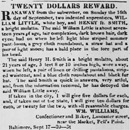Fugitives slaves in Maryland often fled without knowing whom they could trust. Runaways sometimes received help from relatives and friends, and sought shelter in cities like Washington, D.C. and Baltimore. They could be captured by slave catchers for large rewards.
Case Study
Slaves occasionally made multiple escapes and, at times, chose to return to their owner. Ben Orme escaped from Three Sisters Plantation of Prince George's County at least three times. In his attempt in 1812, Ben was caught. he escaped again with Peter and Andrew Ridout during the British invasion of Maryland in 1814. Perhaps fearing that recapture would bring harsher consequences than voluntarily returning, Ben left the Ridout brothers to go back to his masters, Tilghman Hilleary. When he returned, Orme testifies that it was the Ridouts who persuaded him to escape and that he last saw them riding off with the British. Ben Orme fled again in 1815, but records show he was returned to slavery by 1835.
Case Study
Fugitives frequently fled during holidays and periods when their absences were more likely to go unnoticed. Henry H. Smith and William Little, indentured apprentices, escaped from Fells Point in Baltimore on a Sunday in 1832, during a cholera epidemic. The following day their master, William Williams, placed runaway advertisements in Baltimore, Philadelphia, New York, and Boston newspapers. Smith and Little's escape is a rare example of blacks and white fleeing together. While their fate remains unclear, running away as a pair increased the risk of capture.
Child Workers, Baltimore, Maryland
British proclamation offering
immediate emancipation for military
service during the War of 1812.
View of Broadway South
to Market
Three Sisters
Plantation
Discover more at slavery.msa.maryland.gov



 Henry H. Smith fled with William Little from Fells Point in Baltimore on a Sunday in 1832, during a cholera epidemic. Smith was African American and about twenty-one years old. Both Smith and Little worked as indentured apprentices under the confectioner William Williams, who operated a store on Lancaster Street. He advertised in Baltimore, Philadelphia, New York, and Boston newspapers the day after their escape, describing Smith as "quick in answers, very artful, and from the information received, he has decoyed the said William Little away."
Henry H. Smith fled with William Little from Fells Point in Baltimore on a Sunday in 1832, during a cholera epidemic. Smith was African American and about twenty-one years old. Both Smith and Little worked as indentured apprentices under the confectioner William Williams, who operated a store on Lancaster Street. He advertised in Baltimore, Philadelphia, New York, and Boston newspapers the day after their escape, describing Smith as "quick in answers, very artful, and from the information received, he has decoyed the said William Little away."